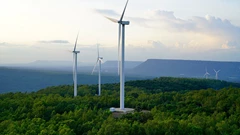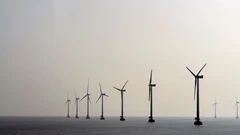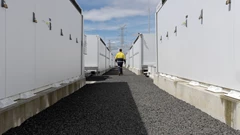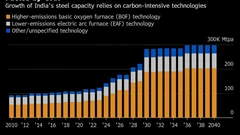It’ll Take More Than Biden’s Economic Plan to Meet Climate Goal
(Bloomberg) -- Climate provisions in President Joe Biden’s tax-and-spending plan are critical to fulfilling his pledge to halve U.S. greenhouse gas emissions by 2030 but are far from enough, according to a new analysis that finds sweeping changes are required to confront global warming.
The U.S. also will have to rapidly accelerate adoption of electric vehicles, impose aggressive emissions limits on individual industries and deploy nascent, yet-to-be-commercialized technologies, according to the World Resources Institute paper released Wednesday. That’s on top of expanding tax incentives for renewable power, advanced energy manufacturing and building efficiency upgrades that are contained in the president’s economic legislation.
“We need a comprehensive suite of policies,” said lead author Devashree Saha. The spending plan pending in Congress and a $550 billion infrastructure package signed last month put the 2030 climate goal “within reach, but it does not take us all the way.”
Biden’s Build Back Better plan contains about $555 billion worth of climate provisions, but it is still subject to changes amid Senate negotiations. If enacted with current tax proposals, the measure could enable the U.S. to pare greenhouse gas emissions 43% from 2005 levels by the end of the decade, according to the WRI analysis.
The paper offers a sobering assessment of the political and technological challenge. For instance, “massive investment in the electricity grid” is required to replace fossil fuels with cleaner options, but new ventures will still have to overcome “permitting and regulatory challenges that can choke off the siting and building of projects.” Even then, WRI found that a clean-energy mandate or policy imposing a price on carbon -- not just tax credits -- was essential to spur significant reductions in the power sector to meet Biden’s 2030 target.
Deeply decarbonizing the transportation sector also will be a formidable feat, requiring “aggressive adoption of zero-emission freight vehicles” and fully phasing out sales of conventional, gasoline-powered passenger vehicles between 2030 and 2040, the analysis says. But stifling emissions from aviation, shipping and off-road transportation equipment will be even harder; without additional policies they would only decline 11% by mid-century and aviation emissions actually could increase, the paper finds.
In the absence of a policy imposing an explicit price on carbon dioxide, states and the U.S. will need to set industry-specific greenhouse gas caps to hit Biden’s commitment under the Paris climate agreement, WRI finds. Those would include vehicle emissions standards, mandates for low- and zero-emission electricity and requirements on buildings and fuel.
Even with an overhaul of the electric power sector and under the most aggressive scenario modeled by WRI, the analysis found the U.S. would still be reliant on natural gas for 15% of its total power generation between 2040 and 2050.
More stories like this are available on bloomberg.com
©2021 Bloomberg L.P.
KEEPING THE ENERGY INDUSTRY CONNECTED
Subscribe to our newsletter and get the best of Energy Connects directly to your inbox each week.
By subscribing, you agree to the processing of your personal data by dmg events as described in the Privacy Policy.
More renewables news

WEC Energy Offered $2.5 Billion US Loan for Renewable Projects

With Trump Looming, Biden’s Green Bank Moves to Close Billions in Deals

GE Vernova Expects More Trouble for Struggling Offshore Wind Industry

Climate Tech Funds See Cash Pile Rise to $86 Billion as Investing Slows

GE Vernova to Power City-Sized Data Centers With Gas as AI Demand Soars

Longi Delays Solar Module Plant in China as Sector Struggles

Australia Picks BP, Neoen Projects in Biggest Renewables Tender

SSE Plans £22 Billion Investment to Bolster Scotland’s Grid

A Booming and Coal-Heavy Steel Sector Risks India’s Green Goals
















